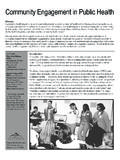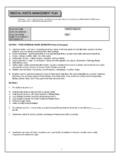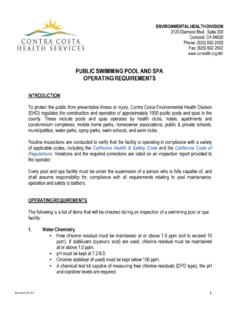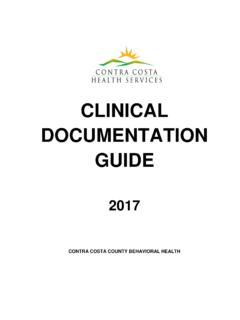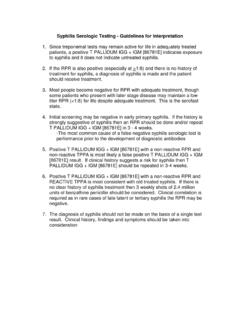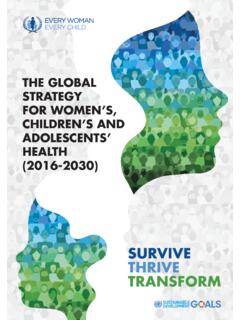Transcription of CALOCUS Version 2010 - Contra Costa Health Services
1 CALOCUS CHILD AND adolescent LEVEL OF CARE UTILIZATION SYSTEM Child and adolescent Version 2010 AMERICAN ASSOCIATION OF COMMUNITY PSYCHIATRISTS October 17, 2010 Edited by: Charles Huffine, ; Steven Jewell, ; Charlotte Hutton, ; Wesley Sowers, 1996-2010 American Association of Community Psychiatrists THIS INSTRUMENT IS PROTECTED BY FEDERAL COPYRIGHT LAW. You may photocopy and use this instrument in this original form. The sole permitted electronic use and/or storage of this instrument is an unmodified, read-only image of the original paper document in PDF (Portable Document Format).
2 The PDF can be downloaded from . You are not permitted to change the instrument in any manner including electronic modifications. You may not store the instrument except as an unmodified PDF file as posted at the above website. You may not change or store the instrument in spreadsheet, database, word processing or other file formats and/or programs. All electronic rights to this instrument are owned by Deerfield Behavioral Health , Inc. More information about electronic/software versions of the instrument can be obtained by contacting Deerfield Behavioral Health , Inc.
3 , at . 2 CALOCUS Instrument 2010 AACP CALOCUS Version 2010 Child and adolescent Level of Care Utilization System American Association of Community Psychiatrists ACKNOWLEDGMENTS The AACP thanks the following individuals, who contributed enormous amounts of time and expertise to the development of this manual: AMERICAN ASSOCIATION OF COMMUNITY PSYCHIATRISTS CHILD AND adolescent COMMITTEE Charles Huffine, ; Wes Sowers, ; Andres Pumariega. AMERICAN ACADEMY OF CHILD AND adolescent PSYCHIATRY WORK GROUP ON COMMUNITY SYSTEMS OF CARE FOR children AND ADOLESCENTS WITH SERIOUS EMOTIONAL DISTURBANCES Andres Pumariega, , Chair; Mark Chenven, ; Emilio Dominguez, ; Ted Fallen, Jr.
4 , ; Katherine Grimes, ; Graeme Hanson, ; William Heffron, ; Robert Klaehn, ; Larry Marx, ; Tom Vaughan, Jr., ; Nancy Winters, ; Al Zachik, ; Charles Huffine, , Consultant; and Kristin Kroeger, AACAP Director of Clinical Affairs. AACP CALOCUS Instrument 2010 3 PA RT I HISTORICAL PERSPECTIVE The need for the Child and adolescent Level of Care Utilization System ( CALOCUS ) stems from two trends in child and adolescent mental Health . 1. The advent of managed care throughout the Health care system in the United States as states encountered limits in their ability to fund Health Services , including mental Health Services .
5 2. Progressive developments in child and adolescent mental Health and allied Services with recognition of the need for better collaboration between elements of the system of care. This culminated in federal action in the mid-1980 s with policies known as Systems of Care (SoC) reforms. These two threads in children s mental Health have resulted in an emphasis on treatment in community settings with limits on access to inpatient and residential Services . CALOCUS provides a framework for defining the appropriate character and intensity of both Services and resources to meet the needs of these children and adolescents.
6 Jane Knitter s, Unclaimed children : The Failure of Public Responsibility to children and Adolescents In Need of mental Health Services , in 1982 identified significant Services gaps for those children most in need of care. She found that many children were inappropriately receiving Services at a higher level of care due to a lack of alternative resources. Ms. Knitter recommended a coordinated range of Services for troubled children and adolescents and the development of placement ensure children are placed in hospitals only when necessary. The federal Child and adolescent Services System Program (CASSP) was founded in 1984 as a response to these identified problems.
7 The 1986 monograph, A System of Care for children and Youth With Serious Emotional Disturbances , by Beth Stroul, , and Robert M. Friedman, , clearly articulates the need for a coordinated continuum of care that includes a broad array of community-based Services . The monograph also provided a set of Guiding Values and Principles for the development of local systems of care. A key element in the SoC reform was the concept of the Wraparound Process. It focuses on empowering parents to be effective partners with therapists and other service providers. It emphasizes a client centered, strength based approach with a high value on creating a team that can coordinate care and bring highly individualized Services to the child and their family.
8 Wraparound plans for a child or adolescent do not rely solely on pre-existing programs, agency Services or conventional levels of care. It is a comprehensive plan, using both formal and informal supports, to remediate unmet needs. It builds on existing strengths of the child and family. Implementation of the SoC approach with its Wraparound Process has been associated with an improved ability to serve children and adolescents safely and effectively in their communities, albeit with specific plans that may represent a definable increase in the intensity of Services . Central to this process has been the rise of family organizations where experienced parents teach parents newer to the system ways of navigating the system as empowered individuals.
9 Experienced parents providing advocacy and support are now considered part of the array of consumer peer support specialists and are recognized by many states as non-credentialed mental Health workers. Similarly older youth solid in their own recovery may be trained to provide peer support Services as well and are beginning to take formal support and advocacy roles with youth in the system of care. CALOCUS has been designed to accommodate the CASSP and SoC principles and facilitate their implementation. 4 CALOCUS Instrument 2010 AACP As managed care progressed in the 1990 s and matured in the new millennium, there has been a greater emphasis on using cost-effective treatments.
10 Modern use of managed care has been found to be a useful tool for effective utilization of limited mental Health and associated resources. Too often, there has been disagreement between payers, providers and consumers regarding the most appropriate Level of Care. VanDenBerg and Grealish pointed out in a 1996 article that, If the adults disagree, the child fails. CALOCUS provides a process that facilitates the development of consensus on level of care determination that is urgently needed. PA RT I I FOUNDATIONS AND PRINCIPLES There have been a number of previous attempts to use clinical assessments as a method of determining level of care needs in children and adolescents.

